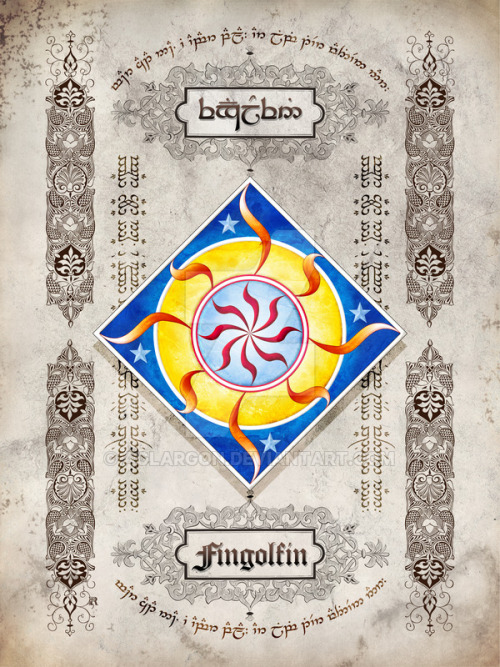#finwë nolofinwë
-Tengwar&Sarati inscriptions (Q): Már cata ná, i ambar palla. Ar limbi tier vantien nar.
-Translation: Home is behind, the world wide. And many paths are for walking.FINGOLFIN
Fingolfin’s father-name was Ñolofinwë (Quenya: “Wise Finwë”, from the Quenyan ‘ngolod’ [“wise”]; pron. Noldorin [ˌŋoloˈfinwe], Vanyarin [ˌŋoloˈɸinwe], 3rd Age Exilic Quenya [ˌnoloˈfinwe]). His mother-name was Aracáno (“High Chieftain”, from ara [“high”] and káno [“chieftain”]; pron. [ˌaraˈkaːno]). Fingolfin is the Sindarin form of his father-name, with the word Finwë added to the beginning (the actual Quenya equivalent would be Finwë Ñolofinwë). The addition was done by Fingolfin himself in pursuance of his rightful claim to be High King of the Noldor after his father’s death.
Fingolfin was the second High King of the Ñoldor in Beleriand, the Ñoldor being one of the three branches of Elves. He was the eldest son of Finwë and Indis, younger brother of Findis, older brother of Irimë and Finarfin, and the younger half-brother of Fëanor. He founded the House of Fingolfin, which ruled the Ñoldor in Middle-earth. His wife was Anairë and his children were Fingon, Turgon, Aredhel, and Argon. Fingolfin was said to be the strongest, most steadfast, and most valiant of Finwë’s sons.
Post link
The Eldar had formulated rules or principles for the shaping of heraldic devices, which can be summarized in the following way:
- Devices for males were placed within a lozenge.
- Devices for females were placed within a circle.
- Devices for families,housesorcountries were placed within a square.
- The rank of the owner was shown by the number of “points” reaching the outer rim of the device. Four points signified a prince, six to eight signified a king. The oldest of the Elven kings, like Finwë, could sometimes have as many as 16 points.
The rules of heraldry were usually followed by both the Noldor and the Sindar, which might indicate that they were already in existence (albeit in a crude form) at Cuiviénen.
But it is tempting to argue that at that time the Quendi were not yet culturally “sophisticated” enough for such ideas. The rules may also have evolved over time, and become known by oral tradition before recieving written form.
If the rules were invented by the Noldor, which would otherwise seem likely, it seems strange that the Sindarin heraldry follows these rules, considering Thingol’s anti-Noldorin politics.
One thing that supports the Noldor as being the originators of the rules is that the Noldorin royals generally seem to have been given higher “status” in their devices, according to the rules above.
Fingolfin’s device shows a distinct relatedness with the device of Fingolfin’s older brother, Fëanor, with the natural exception of Fëanor’s Silmaril.

The silver stars on blue background is probably the source of the blue and silver of Fingolfin’s banners mentioned in The Silmarillion. Eight “points” reach the edges, as is the case with all the devices for the sons of Finwë.

